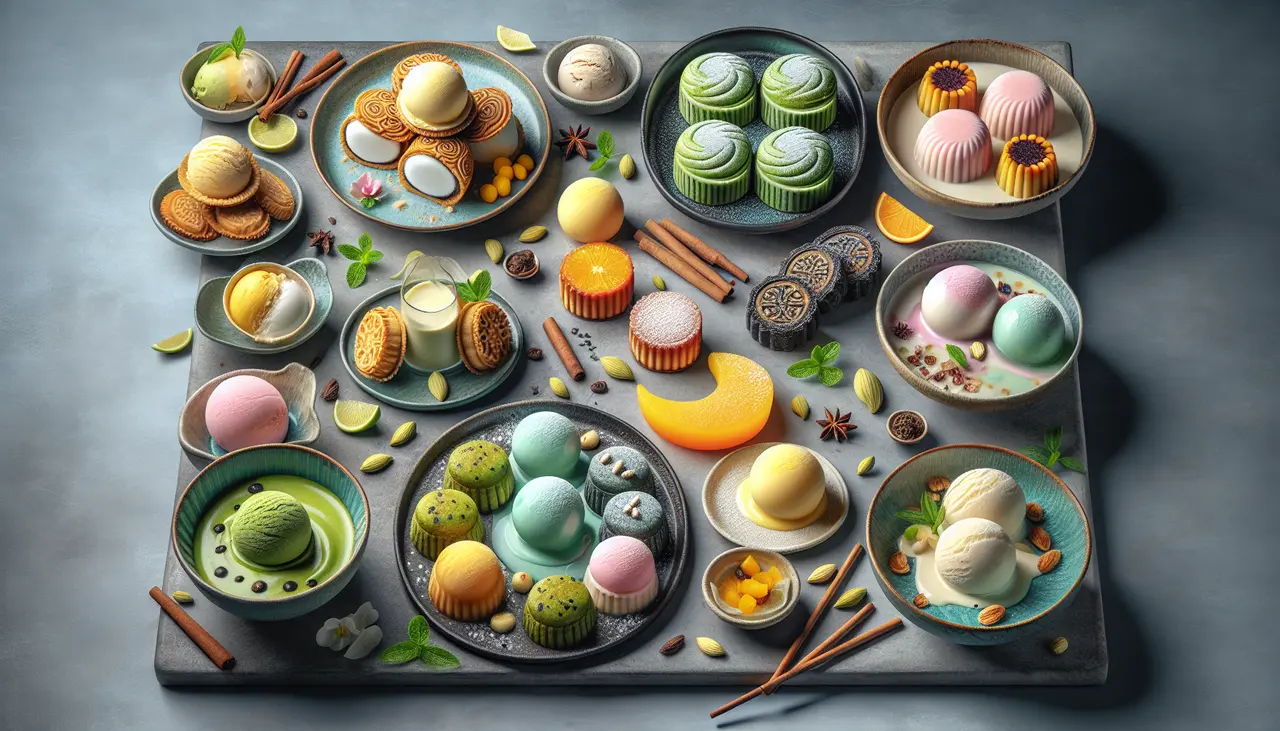Introduction to Asian Fusion Desserts
Asian fusion desserts are taking the culinary world by storm, blending the best of different Asian cuisines with Western dessert traditions to create something truly unique and mouthwatering. Think of it as taking the familiar—cakes, ice creams, and pastries—and giving them an exciting twist with flavors like matcha, sesame, yuzu, and taro. This fusion isn’t just about novelty; it’s a celebration of cultural diversity, showcasing how different culinary traditions can come together to create something spectacular. From matcha green tea tiramisu to black sesame ice cream, these desserts offer a refreshing change from the usual, tapping into a rich palette of flavors that are both exotic and comforting. Essentially, Asian fusion desserts are all about breaking the mold and experimenting with ingredients in ways that surprise and delight the palate, proving that when it comes to food, innovation has no borders.
The Origins of Asian Fusion Cuisine
Asian Fusion cuisine isn’t a new trend, but it has certainly taken the world by storm in recent times. At its core, it’s about merging traditional Asian recipes with ingredients and cooking techniques from other cultures. This culinary experimentation started to gain momentum in the 1970s when chefs began to play with combining flavors from different Asian countries. Then, it evolved, incorporating elements from Western cuisines. This blend not only represents a cross-cultural exchange but also showcases a creative approach to cooking that respects traditional practices while pushing boundaries. The rise of Asian Fusion was propelled by the global movement of people and the increased accessibility of diverse ingredients. This cuisine challenges the purist notions of culinary traditions, proving that innovation can create new taste experiences without losing respect for the original dishes.
Popular Asian Ingredients in Fusion Desserts
When it comes to fusion desserts, chefs love mixing things up by bringing together the best of different culinary traditions. In the case of Asian fusion desserts, the magic really happens when traditional Asian ingredients are thrown into the mix. So, what are these popular ingredients that have dessert lovers excited? First off, matcha steals the spotlight. This finely ground green tea powder from Japan not only adds a vibrant green color but also brings a unique, earthy flavor to cakes, cookies, and ice creams. Next, there’s black sesame. It might sound unusual if you’re new to it, but its nutty, slightly sweet taste makes for an unforgettable ice cream or cake. Then we have red bean paste, a staple in many Asian desserts. It’s smooth, sweet, and works perfectly in everything from pastries to popsicles. Another game-changer is mochi, a chewy Japanese rice cake that adds texture to ice cream and other sweet treats. And let’s not forget about coconut milk, which gives a creamy, tropical twist to cakes, mousses, and more. These ingredients are just the starting point. Chefs continue to experiment, blending these flavors with Western dessert concepts to create something truly unique and delicious.
How Chefs are Innovating with Asian Fusion Desserts
Chefs are getting creative, mixing ingredients from different Asian cultures to whip up desserts that surprise and delight. They’re not afraid to experiment. For instance, they might take matcha, a traditional Japanese green tea powder, and blend it with coconut, a staple in Southeast Asian cooking, to create a Matcha Coconut Ice Cream that’s both refreshing and rich. Or think about merging the delicate flavors of Chinese lychee with the tartness of Korean kimchi to create a bold, unexpected sorbet. These culinary pioneers use what’s familiar and push it into the realm of the extraordinary. They pay tribute to traditional Asian desserts while inviting those not familiar with these flavors to explore them in a new context. It’s all about balancing the old with the new, the familiar with the surprising. That’s the heart of innovation in Asian fusion desserts.
Top 5 Must-Try Asian Fusion Desserts
When it comes to sweets, Asian fusion desserts break all the rules. Mixing flavors and techniques from various cultures, they create something truly unique. Here are the top 5 you can’t miss. First, Mochi Ice Cream. It’s a game-changer. Soft, chewy mochi wrapped around creamy ice cream in flavors like matcha or black sesame. Next, Bubble Tea Pancakes. Imagine fluffy pancakes packed with boba pearls, drizzled with condensed milk. Sounds weird? Tastes amazing. Then, there’s the Matcha Tiramisu. It takes the Italian classic and spins it with bold matcha green tea. A fusion at its finest. Don’t overlook Sesame Creme Brulee. It’s a twist on the French dessert, with a rich sesame flavor cracking under your spoon. Last up, Thai Tea Parfait. Layers of Thai tea mousse, crunchy bits, and whipped cream. It’s not just dessert; it’s an experience. Trust me, diving into these desserts is like taking a trip without leaving your table. With every bite, you’re exploring a new world of tastes.
Fusion Techniques: Blending East and West in the Kitchen
Fusion techniques are all about mixing ingredients and recipes from different cultures, especially Asian and Western, to create something new and exciting. Think of it as taking the best from both worlds – the delicate flavors from the East, like matcha, lychee, and red bean, and combining them with popular Western dessert foundations, such as pastries, chocolates, and cakes. Here’s the deal: to master fusion desserts, chefs play with contrasting flavors and textures. They might add matcha powder to a traditional cheesecake to give it a unique, earthy flavor, or use mochi, a soft and sticky rice cake from Japan, as a filling for French macarons. The result? Desserts that surprise and delight with each bite. The key is balance. You don’t want one culture to overshadow the other, but rather to complement each other, creating a harmonious blend that’s both intriguing and delicious. This approach not only opens up a world of flavor combinations but also invites creativity and innovation in the kitchen, making dining a truly global experience.
The Role of Social Media in Popularizing Asian Fusion Desserts
Social media has been a game-changer for Asian fusion desserts. Platforms like Instagram and TikTok play a huge role. Here’s the deal: when someone posts a drool-worthy snap or video of a matcha lava cake or a taro bubble tea cheesecake, it spreads like wildfire. Users see these vibrant, unique desserts and immediately want to try them or make them at home. This isn’t just about looking good. It’s about stories and experiences. Influencers traveling across Asia share local treats with a twist, sparking curiosity. Chefs and home cooks experiment and showcase their creations online, reaching millions without needing a physical bakery. Social media turns these desserts from local delights to global trends fast. It’s not just about eating; it’s about sharing food stories. That’s why Asian fusion desserts are more than a fad—they’re a flavorful journey across cultures, powered by shares, likes, and hashtags.
Finding Authenticity in Fusion: Keeping Traditions Alive
Fusion doesn’t mean forgetting where we came from. It’s about taking the best of both worlds and creating something unique. When we talk about Asian fusion desserts, we’re blending traditional flavors with modern twists. It’s easy to think that this might mean losing the essence of traditional sweets, but that’s not the case. Chefs are very careful to keep the soul of these desserts intact. It’s not just about throwing together ingredients from different cultures. It’s more about respecting each tradition and finding a balance that highlights both. For instance, imagine taking the smooth, creamy texture of classic Japanese matcha ice cream and combining it with the bold, spicy notes of traditional Indian chai spices. The result? A dessert that’s both familiar and completely new. Chefs dive deep into each culture’s history to understand the significance of each ingredient before creating a fusion dessert. This thoughtful approach ensures that each new creation pays homage to its roots while paving the way for new tastes and experiences. So, next time you dig into a bowl of taro and coconut milk panna cotta or a plate of mochi waffles topped with mango and sticky rice, remember – it’s all about celebrating traditions, not forgetting them.
DIY: Simple Asian Fusion Dessert Recipes for Home Cooks
Stepping into the world of Asian Fusion desserts at home is easier than you think. It mixes traditional Asian flavors with Western dessert concepts, resulting in treats that are both unique and delicious. Let’s start with two simple recipes that anyone can make. First, a Matcha Cheesecake. You need cream cheese, sugar, eggs, and the star ingredient – matcha powder. Mix these, bake, and you’ve got a vibrant, earthy dessert with a twist. Second, Mango Sticky Rice Spring Rolls. Take sticky rice, add coconut milk and sugar, then wrap it with a slice of mango in a spring roll wrapper. Fry or bake until golden. Dip in sweet coconut sauce for an extra layer of joy. These recipes show it’s not about complicated steps but about combining the right flavors. Give them a try and impress yourself and others with your Asian Fusion dessert creations.
The Future of Asian Fusion Desserts: Trends to Watch
Asian fusion desserts are evolving, and fast. Imagine biting into a dessert and tasting a mix of flavors from Japan, India, and Thailand – that’s the future we’re heading into. What’s driving this change? A big reason is our growing curiosity about different cultures and their cuisines. Folks want to try something new, something out of the ordinary, and chefs are more than happy to experiment.
Here are the trends to watch: Dessert Sushi is becoming a thing. Think mango and sticky rice rolled up like sushi, but sweeter. Matcha is already popular, but expect to see it in more than just lattes. Matcha-flavored cakes, cookies, and even ice creams are picking up steam. Vegan and Gluten-Free Options are on the rise too. As more people prefer plant-based diets, ingredients like coconut milk and almond flour are becoming common in Asian fusion desserts.
The emphasis on local and seasonal ingredients is another trend. Chefs are using local fruits and spices to add a unique twist to traditional desserts. This not only supports local farmers but also reduces the carbon footprint.
Lastly, interactive desserts are gaining popularity. Desserts that you can assemble yourself or that change texture when you eat them are becoming more common. It’s not just about taste anymore; it’s about the experience.
So, get ready to see (and taste) desserts that are not only delicious but are a melting pot of cultures, innovatively combining flavors in ways you might not have imagined before.








Leave A Comment